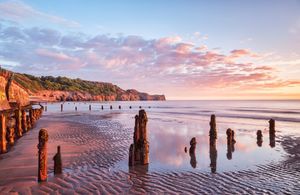Panel of independent experts publish findings into crab deaths
The panel of independent experts set up to assess the cause of dead and dying crabs washed up on shores from October 2021 have published their findings

Sunrise at Sandsend Beach, Whitby
The panel of independent experts set up to assess the cause of dead and dying crabs washed up on shores from October 2021 have today (Friday 20 January) published their findings.
The panel, made up of experts from academia and industry, was chaired by Defra’s Chief Scientific Adviser Gideon Henderson with input from the Government Chief Scientific Adviser, Sir Patrick Vallance.
They investigated a number of possible causes for the unusual crab deaths which started in October 2021 including a potential disease or parasite, a harmful algal bloom, chemical toxicity including pyridine, and dredging which could have released a toxic chemical. Each of these potential causes was assessed according to the likelihood of the occurrence.
The key observations that must be explained by any cause include: Mortality over a sustained period and along at least 70km of coastline; the unusual twitching by dying crabs observed in many locations; and the deaths being dominantly crustaceans rather than a wider range of species.
The panel concluded:
-
It is about as likely as not that a pathogen new to UK waters – a potential disease or parasite - caused the unusual crab mortality. There are pathogens known to cause similar symptoms to those observed in the north-east and these pathogens have caused mortality events and declines in crustacean populations around the world. No significant pathogens were identified in the north-east crabs but full molecular screening was not conducted at the time of the initial investigation.
-
It is unlikely that a harmful algal bloom or that a loss of oxygen in the water associated with the algal bloom caused the crab deaths. The panel assessed satellite data and water-column measurements and concluded that the presence of an algal bloom in the area during September 2021 was likely but it was unlikely that the bloom persisted beyond October 2021.
-
It is very unlikely that pyridine or another toxic pollutant caused the crab deaths. The panel considered industries on Teesside and concluded they could not be sources of any significant volume of pyridine during the period of the crab deaths. Measurements of seawater by the Environment Agency and York University could not detect pyridine. Sediment measures of pyridine from dredged material and other toxic chemicals found in sediments in the Tees are significantly lower than the levels which would cause crab mortality.
-
It is very unlikely that maintenance dredging, as required to keep the port open, was the cause; a dredger operated in the channel offshore Teesside during late September and early October 2021 but the maximum possible release of toxic chemicals, including of pyridine, caused by this activity is significantly too small to cause crab mortality.
-
Capital dredging (i.e. as required to expand the port) was last carried out in December 2020, some time before deaths started in October 2021. Further capital dredging did not commence until September 2022. It is therefore exceptionally unlikely that capital dredging on the Tees caused the crab mortality seen in the region.
Although there is no direct evidence of a novel pathogen - a disease or parasite - it would explain the key observations including mortality over a sustained period and along 70km of coastline, the unusual twitching of dying crabs and the deaths being predominantly crabs rather than other species..
It is also possible that a combination of factors lead to the unusual mortality, rather than one of the factors the panel considered.
Sir Patrick Vallance, Government Chief Scientific Adviser, said:
I would like to thank the scientists who have been involved in the expert assessment of this unusual crustacean mortality. For a complex issue like this it is important to have a range of experts involved who can offer independent challenge and analysis.
Whilst with the current data there cannot be a definitive answer, the options for possible causes and an analyses of likelihood are clearly laid out in the report.
Gideon Henderson, Defra Chief Scientific Adviser, said:
The report summarises thorough and insightful analysis of diverse relevant data by an impressive group of leading marine scientists from across the UK. Their combined knowledge allowed expert assessment of all possible causes of the unusual crustacean mortality.
The panel was unable to identify a single clear cause, but it has been able to point to those more likely to explain the key features of the outbreak.
Environment Secretary Thérèse Coffey asked Defra’s Chief Scientific Advisor Gideon Henderson to liaise with the Government Chief Scientific Adviser Sir Patrick Vallance to establish an independent group, following a request from the Environment, Farming & Rural Affairs (EFRA) Select Committee. The Crustacean Mortality Expert Panel (CMEP) was convened from December 2022 to independently assess the causes of the unusual deaths.
The panel was established with experts from academia and industry with a range of knowledge and experience.
The full report is available here.